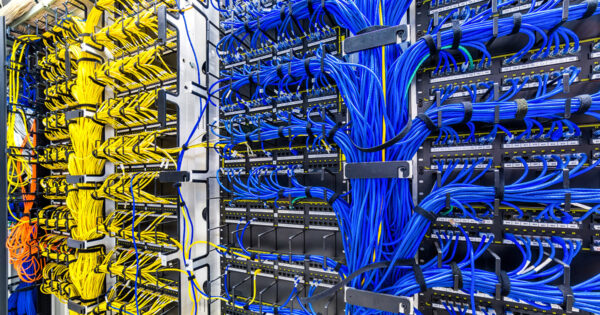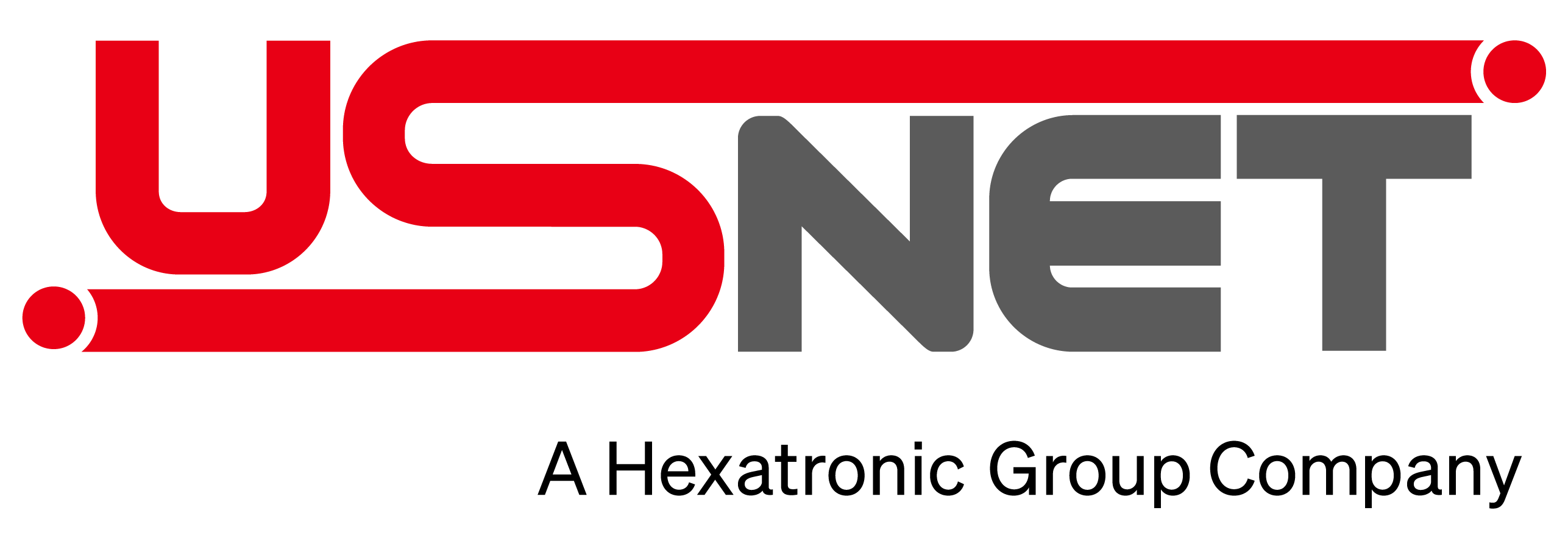
A robust and well-designed cabling infrastructure is not just a convenience but the foundation of a successful IT environment.
At USNet, we understand the critical role that structured cabling plays in ensuring optimal performance, reliability and scalability for your data center operations.
“The connectivity provided by cabling infrastructure is the foundation of every data center — enabling the transactions that help businesses make mission-critical decisions every day,” says DataCenters.com, a technology marketplace and aggregator. All data centers have various cabling types, ranging from all-copper installation to all-fiber installation and everything in between (depending on your equipment and requirements).”
Whatever path and form your structured cabling infrastructure takes — fiber optic, ethernet or copper components — it helps create and maintain a stable and efficient IT ecosystem.
This article will explore the importance of a robust cabling infrastructure, highlight best practices, and explain how USNet’s expertise can elevate your data center’s performance to new heights.
What “Robust Cabling” Signifies in IT and Data Centers
In the context of IT and data centers, a robust cabling infrastructure refers to a well-designed and implemented system of cables that ensures reliable, high-performance data transmission. Here’s a breakdown of the key aspects:
- Reliability: The cabling system should minimize downtime and data errors. This involves using high-quality cables that meet industry standards and are properly installed and maintained. Redundancy (having backup pathways) can also be incorporated for critical connections.
- Performance: The cables need to handle the ever-increasing data demands within a data center. This may involve using cables with higher bandwidth capacities (like fiber optics) and optimizing cable routing for minimal signal interference.
- Scalability: The cabling infrastructure should be designed to accommodate future growth. This means having enough space and flexibility to add new cables and equipment as the data center’s needs evolve.
- Security: Cabling should be strategically placed to minimize physical access and potential tampering. Additionally, proper labeling and documentation ensure efficient troubleshooting and maintenance.
- Organization: A well-organized cabling system is easier to manage and troubleshoot. This includes using cable management tools like trays, ladders and panels to keep cables neat and separated.
- By focusing on these aspects, a robust cabling infrastructure becomes the backbone of a smoothly functioning data center, enabling efficient data flow, high uptime, and the ability to adapt to changing needs.
The Foundation of IT Performance: Understanding Structured Cabling
Structured cabling is the cornerstone of any modern IT infrastructure. It refers to a comprehensive system of cables and associated hardware that provides a versatile and future-proof telecommunications infrastructure.
“When predefined standards based on design, with preset connection points and pathways, are employed, it follows a structured cabling design,” says DataCenters.com.
- A well-designed structured cabling system offers numerous benefits:
- Improved organization and ease of maintenance
- Enhanced flexibility for moves, adds and changes
- Increased reliability and reduced downtime
- Better scalability to accommodate future growth
- Simplified troubleshooting and problem resolution
By investing in a high-quality structured cabling solution, organizations can create a solid foundation for their IT operations, ensuring smooth data transmission and communication across all systems.
Key Elements of a Robust Cabling Infrastructure
A truly robust cabling infrastructure incorporates several key elements:
- Fiber-optic cabling: Known for its high bandwidth capacity and ability to transmit data over long distances, fiber-optic cables are essential for high-speed, long-range connections within data centers and between facilities.
- Ethernet cabling: The backbone of most local area networks (LANs), Ethernet cables come in various categories to support different speeds and distances. Choosing the right Ethernet cabling is crucial for optimal network performance.
- Copper cabling: While gradually being replaced by fiber in many applications, copper cabling still plays a vital role in many IT environments, particularly for shorter distances and power-over-Ethernet applications.
- Quality components: From connectors and patch panels to racks and cable-management systems, every component in your cabling infrastructure should be of the highest quality to ensure reliability and longevity.
Understanding how all these components work together is necessary for your data center to operate at peak performance.
Common Challenges in Data Center Cabling
Despite its importance, many organizations face challenges when it comes to their cabling infrastructure.
“Cables are some of the most pervasive objects you’ll find in a data center. Unfortunately, they can also be among the ugliest and most difficult to deal with,” says Data Center Knowledge. “A data center of average size could easily contain thousands of individual power and networking cables of various types, and if you don’t keep them well-organized, your data center may end up looking like a Silly String battleground. Worse still, you might not know which cables go where, making it difficult to ensure optimal equipment performance and troubleshoot problems.”
Here are some the common challenges in data center cabling:
- Scalability issues: As data centers grow, cabling systems must be able to accommodate new equipment and increased bandwidth requirements without major overhauls.
- Cable management: Poor cable management can lead to airflow problems, difficulty in maintenance and increased risk of human error during changes or troubleshooting.
- Performance bottlenecks: Outdated or improperly installed cabling can create bottlenecks that hinder overall system performance and user experience.
- Future-proofing concerns: With technology evolving rapidly, cabling infrastructure must be designed with future needs in mind to avoid frequent and costly upgrades.
Best Practices for Optimal Cabling Performance
Implementing a robust structured cabling system requires adherence to industry best practices. At USNet, we follow these key principles to ensure optimal performance and longevity of your cabling infrastructure:
- Proper Cable Selection
- Choose the right cable type for each application (e.g., Cat6a for high-speed Ethernet, single-mode fiber for long-distance runs).
- Consider future bandwidth needs and select cables that can support potential upgrades.
- Use plenum-rated cables in air-handling spaces for fire safety compliance.
- Efficient Cable Routing
- Maintain minimum bend radius to prevent signal degradation.
- Use cable trays and J-hooks to keep cables organized and off the floor.
- Separate power cables from data cables to minimize electromagnetic interference.
- Precise Cable Termination
- Follow TIA/EIA-568 standards for consistent color coding and pin assignments.
- Use high-quality connectors and ensure proper crimping techniques.
- Perform thorough testing of each terminated cable to verify performance.
- Comprehensive Labeling and Documentation
- Implement a clear, consistent labeling system for all cables, ports and panels.
- Create detailed cable maps and maintain up-to-date documentation.
- Use durable labels that can withstand environmental factors.
- Future-Proofing Design
- Install additional conduits and pathways for future expansion.
- Leave slack in cable runs to accommodate potential reconfigurations.
- Consider implementing a zone cabling approach for greater flexibility.
- Environmental Considerations
- Ensure proper cooling and airflow in cable-dense areas.
- Use outdoor-rated cables for any exterior runs.
- Implement moisture protection in areas prone to high humidity.
- Regular Maintenance and Inspections
- Conduct periodic visual inspections of cable conditions.
- Perform regular performance testing to identify potential issues early.
- Keep cable management systems organized to prevent tangling and damage.
- Security Measures
- Implement physical access controls to protect critical cabling infrastructure.
- Use tamper-evident seals on key connection points.
- Consider armored cables for added protection in high-risk areas.
- Standardization Across the Organization
- Develop and enforce company-wide cabling standards.
- Ensure consistent practices across all locations and departments.
- Provide training to IT staff on proper cabling procedures.
- Compliance with Industry Standards
- Stay up-to-date with the latest TIA/EIA, ISO/IEC and BICSI standards.
- Ensure all installations meet or exceed relevant local and national codes
- Obtain necessary certifications for mission-critical installations.
By adhering to these best practices, USNet ensures that your structured cabling system is not only high-performing and reliable but also scalable and future-ready.
USNet’s Structured Cabling Solutions
At USNet, we pride ourselves on delivering top-tier structured cabling solutions that ensure your data center operates at peak performance. Our services include:
- Custom Solutions: We design and build infrastructure from the ground up and modify existing systems, providing a stable, standard and well-structured system that can adapt to changes and growth.
- Certified Technicians: Our BICSI and vendor-certified technicians ensure that our buildouts not only meet but exceed TIA/EIA and ISDN standards.
- Comprehensive Support: We install and support patch cables, cable assemblies, patch panels, cross-connects, racks, cabinets and power components, ensuring long-term operational performance.
Flexibility is the key to our success, allowing us to help you stabilize, design or build out a new location or solution around your needs.
By prioritizing the quality and design of your structured cabling system, you can create a solid foundation for reliable, scalable and efficient data center operations.
Let us help enhance your data center’s performance with USNet’s structured cabling solutions. Contact us today to learn more about our services and schedule a consultation.

Recent Comments